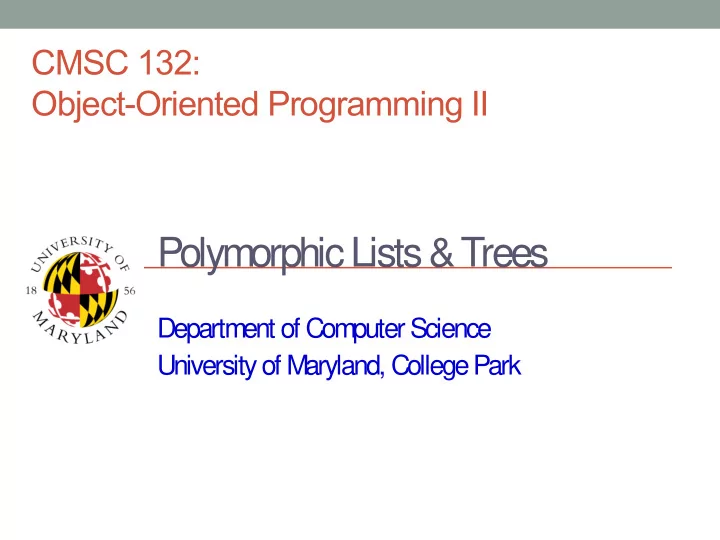

CMSC 132: Object-Oriented Programming II Polymorphic Lists & Trees Department of Computer Science University of Maryland, College Park
Polymorphic Binary Search Trees • Second approach to implement BST • What do we mean by polymorphic? • Implement two subtypes of Tree – EmptyTree – NonEmptyTree • Use EmptyTree to represent the empty tree – Rather than null • Invoke methods on tree nodes – Without checking for null (IMPORTANT!)
Polymorphic Binary Tree Implementation Interface Tree { Tree insert ( Value data1 ) { … } } Class EmptyTree implements Tree { Tree insert ( Value data1 ) { … } } Class NonEmptyTree implements Tree { Value data; Tree left, right; // Either Empty or NonEmpty Tree insert ( Value data1 ) { … } }
Standard vs. Polymorphic Binary Tree Class Node { Class EmptyTree {} Node left, right; Class NonEmptyTree { } Tree left, right; NonEmptyTree X { } left = Y; right = Z; Node X { } left = Y; right = Z; } NonEmptyTree Y { NonEmptyTree Z { left = ET ; left = ET ; right = ET ; right = W; Node Y { Node Z { } } left = null; left = null; right = null; right = W; } } EmptyTree { } EmptyTree { } EmptyTree { } NonEmptyTree W { left = ET ; Node W { right = ET ; left = null; } right = null; } EmptyTree { } EmptyTree { }
Singleton Design Pattern • Definition – One instance of a class or value accessible globally • Where to use & benefits – Ensure unique instance by defining class final – Access to the instance only via methods provided • EmptyTree class will be a singleton class
Singleton Example public final class MySingleton { // declare the unique instance of the class private static MySingleton uniq = new MySingleton(); // private constructor only accessed from this class private MySingleton() { … } // return reference to unique instance of class public static MySingleton getInstance() { return uniq; } }
Using Singleton EmptyTree Class Node { Class EmptyTree {} Node left, right; Class NonEmptyTree { } Tree left, right; } NonEmptyTree X { left = Y; Node X { right = Z; left = Y; } right = Z; } NonEmptyTree Y { NonEmptyTree Z { Node Y { Node Z { left = ET ; left = ET ; right = ET ; right = W; left = null; left = null; } } right = null; right = W; } } NonEmptyTree W { Node W { left = ET ; left = null; right = ET ; right = null; } EmptyTree ET { } }
Polymorphic List Implementation • Let’s see a polymorphic list implementation • See code distribution: LecturePolymorphicListCode.zip
Polymorphic Tree • Let’s see the different operations for a polymorphic tree
Recommend
More recommend